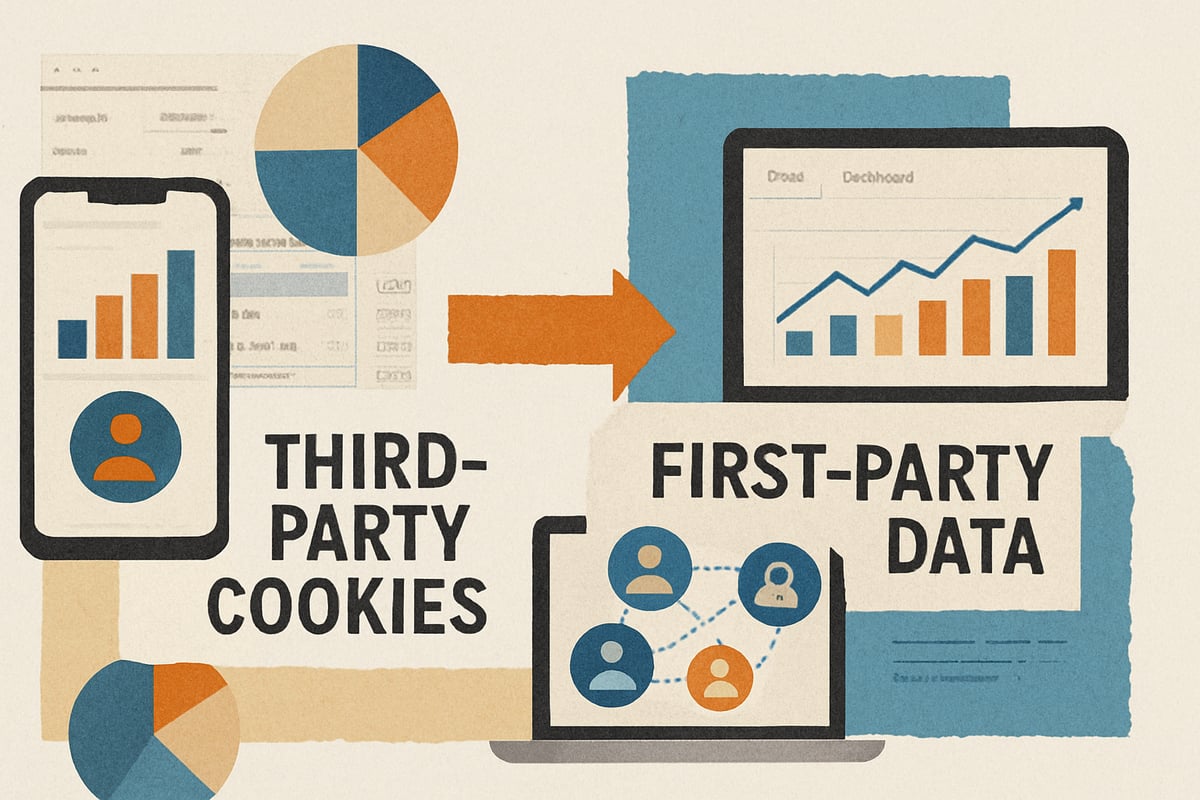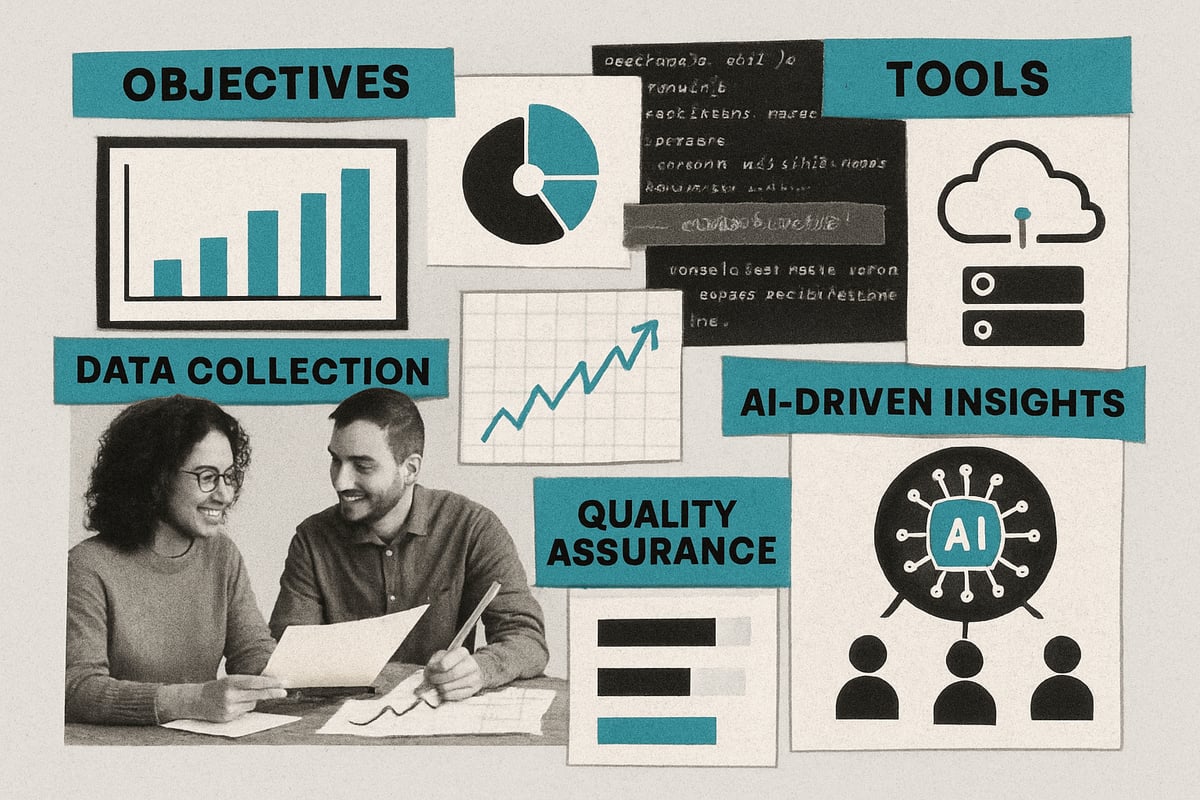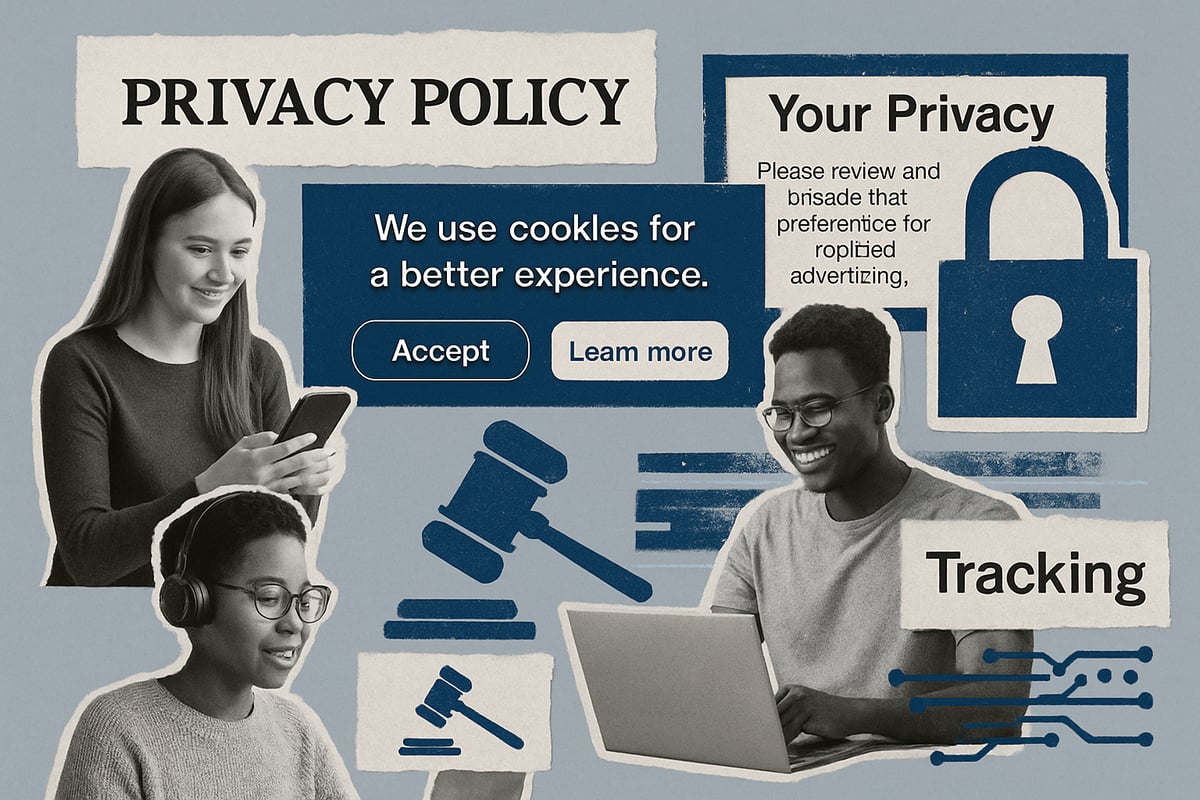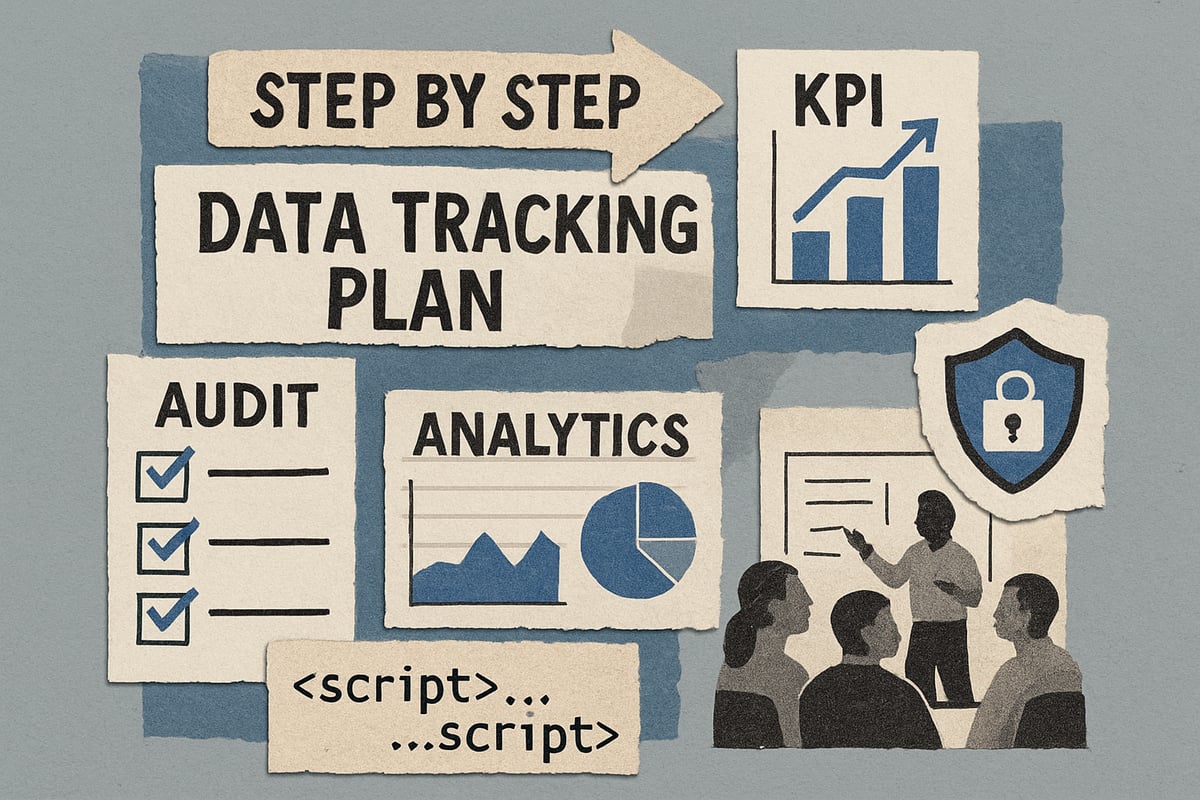- Date
Tracking Data Guide: Strategies and Best Practices for 2025
 Andrii Romasiun
Andrii Romasiun
In 2025, tracking data is at the heart of every successful digital business, yet its complexity and regulatory landscape are evolving rapidly. Companies rely on tracking data to inform decisions, personalize experiences, and drive growth, but must now navigate stricter privacy rules and shifting technologies.
This guide delivers up-to-date strategies for collecting and using tracking data effectively, ethically, and in full compliance with the latest regulations. You will learn what tracking data means today, which tools and methods work best, how to address privacy concerns, and the steps for implementing a reliable tracking plan.
Ready to unlock actionable insights while building user trust? Explore practical tactics and future-proof your analytics in the fast-changing world of tracking data.
Understanding Tracking Data: Definitions, Types, and Value
Tracking data sits at the core of digital business, driving decisions and shaping customer experiences. In 2025, organizations rely on tracking data more than ever to understand user behavior, optimize marketing, and stay competitive in a privacy-conscious world.

What Is Tracking Data and Why Does It Matter?
Tracking data refers to the information collected as users interact with digital platforms, such as websites, mobile apps, or SaaS products. This data helps businesses understand how visitors engage with content, navigate pages, and convert on calls to action.
The role of tracking data extends far beyond simple pageview counts. It provides actionable insights that can improve marketing ROI, drive product innovation, and support compliance with evolving regulations.
Types of Data: First, Second, and Third-Party
Understanding the source of tracking data is crucial. There are three main types:
| Type | Definition | Example |
|---|---|---|
| First-party | Data you collect directly from your audience or customers | Website analytics, purchase history |
| Second-party | Someone else's first-party data, shared with you via partnership | Retailer sharing loyalty data with brands |
| Third-party | Aggregated data from external providers, often via cookies | Ad networks tracking users across sites |
In 2025, the shift from third-party cookies to first-party tracking data is accelerating. With browser restrictions and privacy laws tightening, 80% of businesses plan to increase investment in first-party data, according to recent industry surveys.
Common Tracking Data Types
Tracking data comes in several forms, each offering unique value:
- Behavioral data: Clicks, pageviews, time on site, navigation paths
- Transactional data: Purchases, subscription renewals, cart abandonments
- Demographic data: Age, location, device type
- Technical data: Browser, operating system, load times
For example, e-commerce platforms track abandoned carts to recover lost sales, while SaaS companies monitor feature adoption to refine onboarding.
The Value of Tracking Data for Business Growth
The true power of tracking data lies in its ability to unlock customer-centric strategies. Companies use this information to:
- Personalize user experiences and content
- Build unified customer profiles for targeted campaigns
- Optimize product features and workflows
- Predict churn and improve retention
Competitors are increasingly focused on real-time data collection and unified customer views. These approaches enable faster decision-making and more relevant personalization.
As privacy expectations rise, organizations are adopting privacy-friendly analytics solutions. Platforms that prioritize user consent and transparency, such as those explained in Privacy-friendly analytics explained, are setting new standards for ethical data practices.
Tracking data, when collected and used responsibly, empowers businesses to grow while respecting user trust and regulatory requirements.
Core Strategies for Effective Data Tracking in 2025
Achieving reliable insights and ethical analytics in 2025 begins with mastering core strategies for tracking data. Businesses must adopt a holistic approach, tailoring every step to both organizational goals and evolving privacy standards. Below, we break down proven methods and best practices for building a future-ready tracking data framework.

Setting Clear Data Tracking Objectives
Defining objectives for tracking data is the foundation of any successful analytics strategy. Begin by identifying what your business needs to learn, such as user behavior patterns, conversion rates, or product adoption.
- Map objectives to key performance indicators (KPIs).
- Link tracking data goals to customer journey stages.
- Prioritize actionable metrics over vanity data.
For example, e-commerce brands may focus on tracking data related to abandoned carts and checkout flows. SaaS platforms might prioritize feature usage and retention metrics. Clarity in objectives prevents data overload and ensures every piece of tracking data collected serves a strategic purpose. Revisiting goals regularly keeps your tracking data aligned with evolving business needs.
Choosing the Right Tracking Tools and Platforms
Selecting the right tools is critical for accurate tracking data. Analytics platforms vary in features, integrations, and privacy capabilities. Consider the following comparison:
| Platform | Strengths | Privacy Features |
|---|---|---|
| Google Analytics | Broad adoption, integrations | Consent management |
| Privacy-focused tools | Data minimization, compliance | Cookieless tracking |
| CDPs | Unified customer view | Granular access control |
| Open-source solutions | Customization, ownership | Self-hosted, GDPR-ready |
Unified platforms offer cross-channel tracking data insights, reducing silos. Integration with APIs and tag managers enables flexible configurations. Cloud-based and open-source solutions provide scalability and control. Consider your business size, technical resources, and compliance needs when choosing a platform for tracking data.
Implementing Robust Data Collection Methods
Accurate collection methods are essential for trustworthy tracking data. Best practices include event tracking, pageview monitoring, and custom metric setup. In 2025, server-side tracking is gaining traction for its reliability and privacy benefits, while client-side methods remain common for real-time needs.
Use SDKs, APIs, and tag managers to deploy tracking codes efficiently. Watch for pitfalls like data duplication or missing events. For deeper guidance, consult Event tracking best practices to optimize your tracking data setup.
A typical event tracking implementation might look like this:
analytics.track('Purchase', {
product_id: '1234',
value: 49.99,
});
Regularly validate event triggers and data flows to ensure your tracking data remains accurate and actionable.
Ensuring Data Quality and Accuracy
Maintaining high-quality tracking data requires ongoing vigilance. Implement data validation protocols and monitor for errors or anomalies.
- Schedule regular audits of your analytics setup.
- Use automated tools for data quality checks.
- Document and resolve discrepancies promptly.
Data governance frameworks help standardize processes and assign responsibilities. Platforms often provide error tracking features, alerting you to broken tags or missing events. Consistent validation ensures tracking data supports confident decision-making and regulatory compliance.
Building a Single Customer View Across Channels
A unified customer view is the gold standard for leveraging tracking data. Identity resolution techniques match user interactions across web, mobile, and offline channels, creating a seamless profile.
Merge data from multiple sources, such as CRM, POS systems, and digital analytics. Real-time profile syncing allows marketers to personalize experiences instantly. For example, a retail brand can recognize a customer browsing online and complete their journey in-store, all thanks to integrated tracking data.
Unified profiles power advanced segmentation, targeted messaging, and improved customer satisfaction. Competitors leveraging real-time syncing demonstrate higher engagement and conversion rates.
Leveraging Automation and AI for Data Tracking
Automation and AI have transformed tracking data management. Automated systems handle data collection, cleansing, and reporting, reducing manual errors. AI-driven analytics uncover patterns, predict user behavior, and recommend optimizations.
Competitors highlight the benefits of AI in journey orchestration, enabling faster and smarter decisions. Automation also improves scalability, allowing teams to focus on strategy rather than repetitive tasks.
By integrating these technologies, organizations future-proof their tracking data infrastructure and stay ahead of industry trends.
Privacy, Compliance, and Ethical Considerations
As tracking data becomes central to business analytics, organizations face increasing pressure to balance insight generation with legal and ethical responsibilities. In 2025, privacy laws, evolving technology, and rising user expectations create a challenging environment for responsible data collection. Addressing these demands is essential for sustainable growth and long-term trust.

Navigating Evolving Regulations (GDPR, CCPA, and Beyond)
The landscape for tracking data is shaped by stringent privacy regulations worldwide. Laws like the GDPR in Europe and CCPA in California set the tone for data collection, user consent, and transparency. In 2025, new state and national acts are coming into effect, requiring businesses to adapt their practices.
Key compliance requirements include:
- Obtaining explicit user consent before collecting tracking data.
- Minimizing data collection to only what is necessary.
- Providing clear, accessible privacy notices.
- Ensuring users can access, modify, or delete their data.
Staying current is crucial. For a comprehensive overview, see the U.S. Consumer Privacy Laws Update 2025 for details on the latest state regulations. Competitors are investing in privacy portals and trust centers to streamline compliance and reinforce user confidence. Regular audits and policy updates help organizations remain aligned with shifting legal requirements.
Cookieless Tracking and Consent Management
With third-party cookies fading, tracking data strategies are rapidly evolving. Businesses are turning to cookieless tracking solutions, such as server-side analytics, device fingerprinting, and contextual targeting, to maintain data accuracy while respecting privacy.
Best practices for managing consent include:
- Deploying transparent consent banners that explain tracking data usage.
- Allowing users to easily opt in or out of specific data types.
- Maintaining detailed records of user choices for audit purposes.
Recent surveys show that 70% of users expect full transparency regarding how their tracking data is used. Adapting to cookieless methods while upholding user preferences is essential. Companies that prioritize consent management not only comply with regulations but also foster greater trust with their customers.
Ethical Data Collection and User Trust
Ethical handling of tracking data goes beyond legal compliance. Building user trust requires transparency, clear communication, and a commitment to privacy-first principles. Organizations should anonymize data whenever possible and limit collection to only what supports business objectives.
Examples of ethical approaches include:
- Using privacy-first analytics platforms that avoid personal identifiers.
- Publishing straightforward privacy policies.
- Regularly communicating updates on tracking data practices.
Competitors emphasize the value of ethical data handling as a differentiator in crowded markets. When businesses show respect for user privacy, customers are more likely to engage and share data willingly.
Data Security and Ownership
Securing tracking data is a top priority as threats evolve. Implementing robust encryption, strict access controls, and regular security audits reduces the risk of breaches. Data governance protocols define who can access tracking data and under what circumstances.
Key strategies for data security:
- Encrypt tracking data both in transit and at rest.
- Limit access through role-based permissions.
- Conduct frequent vulnerability assessments.
Ownership is equally important. Users increasingly demand control over their data, including the right to access or request deletion. Open-source and self-hosted analytics solutions offer businesses 100% ownership of their tracking data, minimizing reliance on third-party processors.
Industry best practices recommend documenting all data flows, conducting breach simulations, and training staff in secure handling procedures. By elevating both security and ownership, organizations protect valuable tracking data and reinforce their reputation for responsibility.
Step-by-Step Guide to Implementing a Data Tracking Plan
A structured approach is essential for successful tracking data initiatives in 2025. By breaking the process into clear, actionable steps, organizations can maximize data accuracy, comply with regulations, and create a scalable foundation for analytics. Let’s walk through each key stage to help you build a robust tracking data plan from the ground up.

Step 1: Audit Existing Data and Tracking Infrastructure
Begin your tracking data journey with a comprehensive audit of current analytics tools, data sources, and tracking scripts. Map out which platforms are being used, where data flows, and any custom event tracking in place.
Create a checklist covering:
- Inventory of analytics and tag managers
- Review of data collection points across channels
- Identification of duplicate or outdated tracking scripts
This process helps uncover data silos, redundancies, and compliance gaps. Auditing tracking data infrastructure ensures you have a clear baseline before making improvements or investing in new tools.
Step 2: Define KPIs and Tracking Requirements
Collaborate with stakeholders to set measurable objectives for your tracking data strategy. Begin by mapping key user actions, such as sign-ups or purchases, and align them with business goals.
Document essential KPIs like:
- Conversion rates
- Session duration
- Feature adoption (for SaaS)
Use templates to ensure consistency when recording tracking requirements. By focusing on relevant KPIs, you avoid tracking data overload and ensure insights are actionable for each team.
Step 3: Select and Configure Tracking Tools
Evaluate analytics platforms, customer data platforms (CDPs), and tag management solutions to find the best fit for your tracking data needs. Consider integration capabilities, privacy features, and scalability.
When selecting tools:
- Compare open-source vs. cloud-based solutions
- Check for robust API and SDK support
- Assess real-time reporting options
Configuration is critical. Set up tracking data systems to capture custom events, pageviews, and user properties. For small businesses, lightweight tools may suffice, while enterprises might require more advanced solutions.
Step 4: Develop a Data Governance and Privacy Framework
Establish policies for data access, retention, and sharing to govern your tracking data. Assign roles for data stewardship and ensure your framework aligns with global privacy regulations.
Stay informed on compliance requirements by consulting resources like the 2025 U.S. Data Privacy Compliance Deadlines Infographic, which provides a helpful timeline of upcoming legal obligations.
Best practices for governance include:
- Regular data access reviews
- Clear data minimization policies
- Documented consent management processes
A strong governance framework protects both your users and your organization as you manage tracking data.
Step 5: Implement Tracking and Validate Data
Deploy tracking codes, set up event triggers, and test all data flows to ensure accuracy. Use debugging tools and sandbox environments to validate that tracking data is being collected as intended.
Follow this workflow:
- Install tracking scripts or SDKs
- Trigger test events across platforms
- Use validation tools to confirm data capture
Ongoing monitoring for errors or discrepancies is vital. Address issues such as data duplication or missing events promptly. Proper validation keeps your tracking data reliable and trustworthy.
Step 6: Monitor, Analyze, and Optimize
Set up dashboards for real-time monitoring of tracking data. Analyze user journeys, trends, and conversion funnels to uncover actionable insights.
Key monitoring actions include:
- Regular review of analytics dashboards
- Setting up alerts for anomalies
- Iterating on tracking setup based on findings
Continuous optimization is essential. Use insights from tracking data to refine marketing campaigns, improve user experience, and support data-driven decisions across teams.
Step 7: Document and Train Teams
Maintain thorough documentation of your tracking data setup, including tool configurations, data flows, and governance protocols. Well-structured documentation reduces onboarding time and supports ongoing compliance.
Train stakeholders on interpreting tracking data, privacy requirements, and best practices for data-driven decision making. Foster a culture where every team member understands the value and responsibility of accurate tracking data.
Providing training resources and documentation templates empowers teams to confidently leverage tracking data for business growth.
Advanced Techniques and Trends in Data Tracking for 2025
The landscape of tracking data is evolving rapidly in 2025. Advanced strategies and emerging trends are helping businesses extract deeper insights, improve agility, and deliver seamless customer experiences. Let’s explore the most impactful techniques shaping the future of tracking data.
Real-Time Tracking and Streaming Analytics
Real-time tracking data empowers organizations to react instantly to user behavior and market changes. By leveraging streaming analytics platforms, companies can monitor events as they happen, enabling agile decision-making and immediate response.
Benefits of real-time tracking data include:
- Detecting anomalies or spikes in user activity
- Personalizing offers during live sessions
- Managing inventory dynamically in e-commerce
Competitors are increasingly prioritizing instant data collection, especially for applications like live personalization and fraud prevention. Leading platforms support high-velocity data ingestion, ensuring that tracking data is always up to date and actionable.
Cross-Device and Omnichannel Tracking
Customers interact with brands across multiple devices and channels, making unified tracking data essential for a complete view. Advanced cross-device tracking methods help link user actions from web, mobile, and even offline touchpoints.
Key methods for effective tracking data across channels:
- Device fingerprinting and identity resolution
- Persistent user IDs
- Integration with CRM and POS systems
Challenges like data fragmentation and privacy concerns require robust solutions. For a deeper dive, explore cross-device tracking methods to understand how leading organizations unify tracking data for retail, SaaS, and media use cases.
Predictive Analytics and AI-Driven Insights
Machine learning is transforming how companies leverage tracking data. Predictive analytics models can forecast trends, segment audiences, and detect anomalies that may otherwise go unnoticed.
AI-driven insights from tracking data enable:
- Hyper-personalized marketing campaigns
- Early detection of churn or fraud
- Dynamic content recommendations
Competitors are integrating AI into their marketing journeys, resulting in improved ROI and campaign performance. As algorithms grow more sophisticated, the value of accurate tracking data becomes even more pronounced.
Privacy-First and Cookieless Analytics Solutions
Privacy regulations and the decline of third-party cookies are driving innovation in tracking data solutions. Privacy-first analytics platforms emphasize user consent, anonymization, and ethical data practices.
Emerging features in privacy-focused tracking data tools include:
- Cookieless tracking mechanisms
- Open-source and self-hosted deployments
- GDPR and CCPA compliance
To learn more about effective alternatives and best practices, see this guide on cookie-less tracking solutions. Businesses adopting these solutions are better positioned to build long-term user trust and comply with global standards.
Integration with Business Intelligence and CDPs
Modern organizations rely on seamless integration of tracking data with business intelligence (BI) tools and customer data platforms (CDPs). This unified approach enables advanced segmentation, automated reporting, and activation across channels.
Benefits of integrating tracking data with BI and CDPs:
- Centralized dashboards for real-time analysis
- Enhanced customer journey mapping
- Streamlined campaign activation
Competitor content highlights the importance of robust integrations for scaling insights and maintaining data consistency. Effective data flows between analytics, CRM, and marketing tools are now a cornerstone of data-driven success.
Measuring Success and Continuous Improvement in Data Tracking
To maximize the impact of tracking data, organizations must commit to ongoing measurement and optimization. This process ensures analytics strategies remain relevant, actionable, and compliant as business needs and regulations evolve.
Establishing KPIs and Success Metrics
Defining clear KPIs is the foundation for measuring the success of tracking data initiatives. Start by aligning these metrics with core business objectives, such as increasing user engagement, boosting conversions, or improving retention rates.
Segment KPIs by user journey stages:
- Awareness (impressions, reach)
- Consideration (click-through, engagement)
- Conversion (sales, sign-ups)
- Retention (repeat visits, churn rate)
Benchmark your tracking data against industry standards to identify gaps and opportunities. Competitors often recommend focusing on metrics that directly influence revenue and customer satisfaction. By doing so, teams ensure every data point collected serves a strategic purpose.
Regular Data Audits and Quality Assurance
Routine audits are essential for maintaining the accuracy and reliability of tracking data. Schedule periodic reviews to examine analytics configurations, event tracking, and data flows.
Use automated tools for error detection, such as:
- Data validation scripts
- Dashboard alerts for anomalies
- Scheduled integrity checks
Competitor checklists often highlight common tracking data issues, including duplicate events, missing tags, and broken integrations. Addressing these promptly ensures data-driven decisions are based on trustworthy insights. A robust audit process safeguards both data quality and compliance.
Iterative Optimization and A/B Testing
Continuous improvement of tracking data strategies hinges on iterative optimization. A/B testing frameworks allow teams to experiment with different tracking setups and reporting methods.
Key steps include:
- Designing experiments to compare tracking variations
- Analyzing test outcomes for actionable insights
- Refining event definitions and data collection processes
Competitor case studies show that frequent iteration leads to greater accuracy and richer analytics. The goal is to enhance the value of tracking data over time, enabling more informed business decisions and higher ROI.
Reporting, Visualization, and Stakeholder Communication
Effective reporting transforms tracking data into actionable intelligence for all stakeholders. Create custom dashboards tailored to different teams, ensuring relevant metrics are front and center.
Enhance communication by:
- Using clear, interactive data visualizations
- Telling a compelling story with data
- Sharing regular updates on insights and trends
Competitors emphasize the importance of dashboard customization and user-friendly interfaces. By presenting tracking data clearly, organizations empower teams to make data-driven decisions with confidence and clarity.
Staying Ahead: Adapting to New Technologies and Regulations
The digital landscape is constantly evolving, so tracking data strategies must be adaptable. Stay informed about the latest privacy laws, browser updates, and analytics innovations. Participate in industry forums and ongoing training to keep skills sharp.
Monitoring regulatory changes, such as those described in the EU Artificial Intelligence Act Overview, helps organizations anticipate shifts in compliance requirements. Competitor strategies highlight the value of flexible tracking data infrastructure and proactive adaptation, making resilience a core strength for future success.
As you look ahead to 2025 and consider how data tracking can support both your business goals and your users’ privacy, it’s clear that the right tools make all the difference. With Swetrix, you gain access to privacy-first analytics that are intuitive, GDPR-compliant, and offer full data ownership—without the hassle of cookie banners. Whether you want to unify customer profiles, improve data accuracy, or ensure ethical tracking, Swetrix provides a future-ready solution you can trust. If you’re ready to put these strategies into practice, Try Swetrix today and see the benefits for yourself.